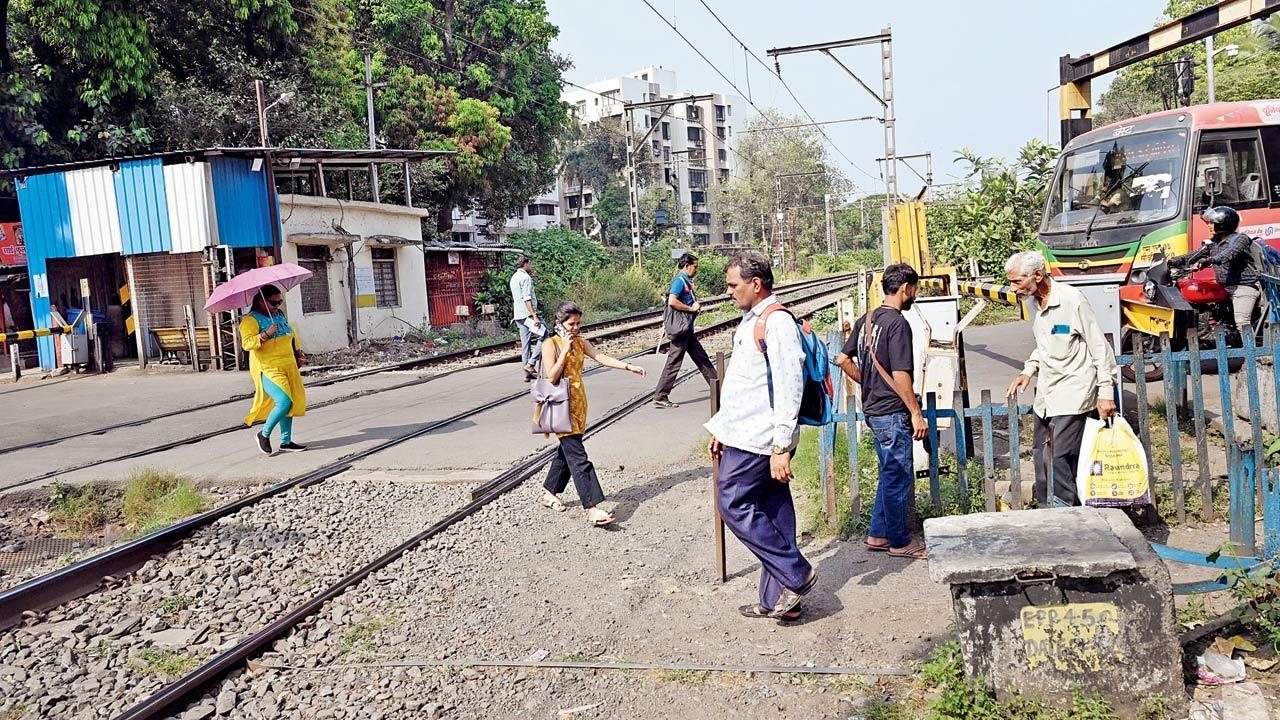BMC plans rail, foot overbridges to end traffic snarls with Rs 37.41-crore project

Chunabhatti rail crossing being used by pedestrians on Thursday. Pic/Sayyed Sameer Abedi
After Vikhroli, another railway level crossing at Chunabhatti is set to shut down in the next few years. The Brihanmumbai Municipal Corporation (BMC) has decided to construct a rail overbridge (ROB) and a separate foot overbridge (FOB) at the Chunabhatti crossing. The bridge is expected to be completed within three years of the project’s commencement.
ADVERTISEMENT
The Chunabhatti rail crossing connects Duncan Causeway in Sion with V N Purav Marg in Chunabhatti. This crossing disrupts both harbour railway traffic and road traffic. The proposal to close the level crossing was first suggested in 2019. Now, the BMC has invited a tender worth R37.41 crore.
Vikas Dhulekar, a biker, said, “I regularly use this road as I live in Chunabhatti. Sometimes we have to wait for up to half an hour. If the bridge is constructed, it will greatly benefit motorists like me.”

Rajan Naik, a local, said the bridge will bring a lot of relief to pedestrians
As per the records, around 40 to 45 BEST buses pass through this level crossing daily. Rajan Naik, a pedestrian and resident of Chunabhatti, said, “If there is a foot overbridge for pedestrians, it will bring relief. Senior citizens and women with children especially suffer due to this railway crossing,” he added.
As per Harbour Railway records, the level crossing is kept closed during peak hours—8 to 9 am and 7 to 8 pm. Generally, the gates remain open for two to three minutes every 15 to 20 minutes, though closures can sometimes last up to 25–30 minutes.
A BMC official told mid-day, “There will be a separate FOB for pedestrians alongside the vehicular bridge. The work will be completed within 32 months of its start. We have invited tenders for the project and aim to begin work as soon as possible.” The bridge will be 290 metres long and feature two lanes.
In 2010, Mumbai Railways sought the help of consultancy firm Final Mile to find solutions to prevent accidents caused by track crossing. Crossing railway tracks remains one of the leading causes of fatalities even today. Final Mile identified three key issues:
1. Ineffective warning signs – Text-based signs failed to grab attention.
2. Horn sounds – Train horns either became too familiar to be effective or were sounded too late to warn people.
3. Misjudgement of train speed – Many people underestimated the train’s speed, leading to overconfidence and fatal miscalculations.
To address these issues, the following design interventions were implemented:
Text-based warning signs were replaced with photographs of actual victims, showing their expressions moments before being struck by a train.
Optimal distances for train horns to sound near trespassing points were calculated.
Yellow stripes were painted on sleepers at intervals. These bright stripes attracted attention and, as they disappeared under a moving train, helped the brain subconsciously recalibrate its perception of the train’s speed.
 Subscribe today by clicking the link and stay updated with the latest news!" Click here!
Subscribe today by clicking the link and stay updated with the latest news!" Click here!







